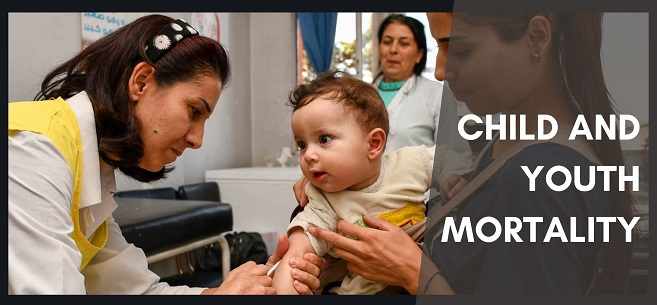Millions more will lose their lives unless all women, children, and young people have access to adequate medical care.
In 2021, some five million children died before reaching the age of five, and another 2.1 million children and young people between the ages of five and 24 died of medical causes that could have been prevented with equitable access to health services and the provision of higher quality maternal, newborn, adolescent and child health care.
According to the latest estimates compiled in a report by the United Nations Interagency Group for the Estimation of Infant Mortality.
A second report from this same (Universal access to health care) organization revealed that, in addition, 1.9 million babies were stillborn during the same period.

Progress is possible
“Every day, too many parents face the trauma of losing their children, sometimes before they even take their first breath,” said Vidhya Ganesh, director of the United Nations Fund’s Division of Data Analysis, Planning and Monitoring. for children
Progress is possible with stronger political will and targeted investment in equitable access to primary health care for every woman and every child.”
Matter of life or death
Access to and availability of quality (Universal access to health care) healthcare remains a matter of life and death for children around the world, the group says.
Most infant deaths occur before the age of five, and a half in the first month of life. For these babies, premature birth and complications during delivery are the leading causes of death.
Similarly, more than 40% of stillbirths occur during childbirth, although most are preventable when women have access to care during pregnancy and childbirth.
For children who survive beyond their first 28 days of life, infectious diseases such as pneumonia, diarrhea, and malaria are the biggest threat.
Investments pay off
The reports also show how increased investments in strengthening primary health systems have benefited women, children, and youth.
The global under-five mortality rate has been cut in half since 2000, while the mortality rates for older children and youth fell by 36% and the stillbirth rate fell by 35%.
This goal aims to end preventable newborn and under-five deaths by 2030. It also includes reducing neonatal mortality to a minimum of 12 per 1,000 live births, and under-five mortality to a minimum of 25 per 1,000 live births.
Millions more at risk
Reports warn that unless swift action is taken to improve health services, almost 59 million children and young people will die before the end of the decade, and almost 16 million stillbirths are likely.
Anshu Banerjee, director of Maternal Health, the Newborn, Children and Adolescents and Aging from the World Health Organization.
Even today, children’s chances of survival remain vastly different depending on where they were born, with sub-Saharan Africa and South-East Asia bearing the heaviest burden.
An investment that pays off
Although sub-Saharan Africa accounted for only 29% of the world’s live births, the region was responsible for 56% of all under-five deaths in 2021, while in Southeast Asia, it was responsible for 26%.
Children born in sub-Saharan Africa also have the world’s highest risk of infant death, 15 times that of those in Europe and North America.
Meanwhile, mothers in sub-Saharan Africa and Southeast Asia are experiencing the painful loss of stillbirth at an exceptional rate.
In 2021, 77% of all stillbirths occurred in these regions, and almost half of all stillbirths occurred in sub-Saharan Africa.
The risk of a woman having a stillbirth there is seven times more likely than in Europe and North America.
COVID-19 future impact
Although the COVID-19 pandemic has not directly increased infant mortality, it may have increased future risks to their long-term survival, according to reports.
Disruptions in vaccination campaigns, nutrition services, and access to primary health care will jeopardize the health and well-being of children for many years.
In addition, the pandemic has also caused the largest continuous rollback in vaccination in three decades, putting the most vulnerable newborns and children at increased risk of dying from preventable diseases.
Reduce inequalities, end deaths
John Wilmoth, director of the Population Division of the United Nations Department of Economic and Social Affairs, has stated that despite the notable progress made since 2000 in reducing under-five mortality, There is still much left to do.
“Only by improving access to quality health care, especially at the time of delivery, can we reduce these inequalities and end preventable newborn and child deaths around the world,” he said.
The United Nations Intergovernmental Group of Experts on Child Mortality was created in 2004 to share data on child mortality and report on global progress toward child survival targets, among other goals.
Related Post
- What drinks are bad for your health over the 40s
- 5 Homemade Smoothies for shredded muscle gain
- How to get a flat tummy fast naturally without exercise